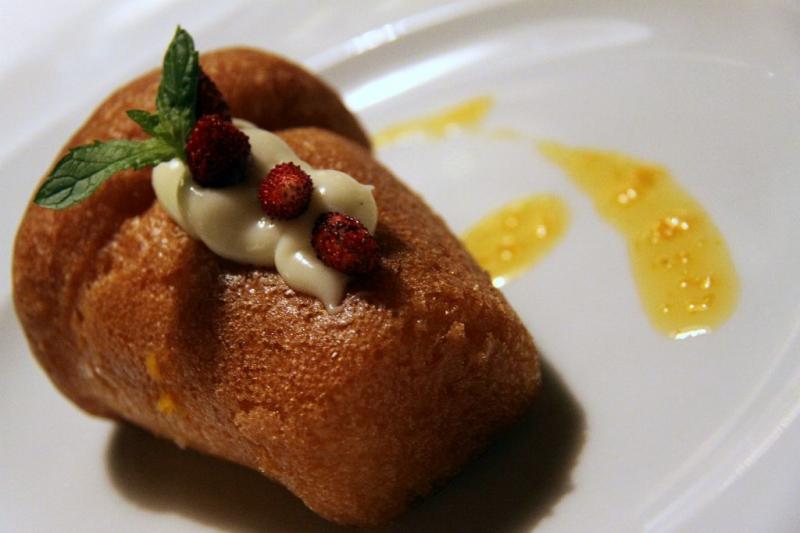One of the good things about autumn is that chestnut flour suddenly hits the shops in enormous amounts. My local supermarket has at least three varieties and my local grocer’s two more. Spoilt for choice, I am using it everywhere—to make crepes, to give a sweet, nutty flavour to cakes, and, of course, to make castagnaccio. I love castagnaccio because it is made with a relatively simple method using everyday ingredients, and it is sweet—but not too sweet. Its exquisite plainness perfectly embodies my idea of Italian cuisine and Italian desserts. Except of course that traditional Italian desserts are often anything but straightforward and simple—especially those of the South.
My ancestors, who came from the length of the Borbonic kingdom of Naples and Sicily and counted among them at least one great struffoli-maker, are probably rolling in their grave at the thought of ending their meal with a plain, boring dolce. Just think of pastiera, sfogliatelle, baba, cannoli siciliani—the grand dessert tradition of Southern Italy is nothing short of a grandiose Baroque-sque triumph of flavours and complex patisserie techniques.
Central and Northern Italy also have their masterpieces of the dessert art—anything from Trentino’s strudel to Tuscan panforte and Romagna’s candied-peel-studded migliaccio—but they are not as rich and numerous as those of the Southern tradition.
I wouldn’t be able to eat pastiera or baba everyday—not in the same way as I can happily munch on homely castagnaccio—and, more importantly, I wouldn’t be able to make them every day. But every once in a while, a grand, complex, rich dessert—something that brings together history, a laborious cooking process and rare, incomparable, sweetness—uplifts the soul. If you are up for it now, here are three of the very best, which are definitely worth trying:
Babà
Baba is a masterpiece of balance—soft and edgy, dry and wet, sweet and alcoholic. Simple in appearance but intricate in the execution, it is the king of Neapolitan patisserie. Even though it is not Neapolitan at all. Legend has it that it was invented by none other than Stanislas Leszcsynski, former king of Poland and Duke of Lorraine, when he spilled some rum on a dry Lorrainian kugelhopf. He took a bite, liked what he was eating and named it after his favourite hero—Ali Baba of The Thousand and One Nights (although the name may well have come from the Polish word babka).
From the court of Lorraine, the baba reached Naples via Paris, courtesy of the many French chefs that went to serve the aristocratic families from the Kingdom of Naples. And it is in Naples that the recipe was perfected—baba became hugely popular, the pastry of choice, mid-morning snack as much as a dessert. So much so that it entered the vocabulary as a synonym of sweet, adorable—“si’ nu baba’ you are a baba, is an endearment commonly used in Naples to mean you are a real treasure.
Baba is most often shaped as a mushroom (although you can also find baba rings), and is occasionally served with cream or custard and a cherry on top (but purists consider this a sacrilege). You can find it in virtually every decent ‘bar’ in Naples, but, if you are prepared to spend a long time in the kitchen and want to try your hand at baking it at home, you can fine a good, traditional recipe here (http://www.baba.it/ricetta-mignon.htm, in Italian only).
Cannoli siciliani
Cannolo is culinary perfection. Crunchy tube, creamy ricotta, powdery icing sugar—the richness of textures prime the palate for the dance of sweet and nutty (in the hazelnut or pistachio versions), fruity (in the candied peel version) or velvety bitterness (in the dark chocolate chips version).
Cannoli were originally a carnival dessert from Palermo, although another story has them first made in the Moorish harem of Kalt El Nissa, Caltanisetta, and a third wants them an invention of pious nuns cloistered in a convent, also in Caltanisetta.
Be as it may, the pastry was first rolled around small reeds (canne) after which the dessert was named. From Palermo (or Caltanisetta), the dessert soon spread around Sicily, Italy and, with the great Sicilian migrations of the early 20th century, the US, where it became a pillar of Italian American cuisine (even though the original recipe was slightly modified to adapt it to local ingredients).
And cannoli continue to make history, at least in Sicily. Earlier in the year, former Sicilian governor Salvatore Cuffaro was photographed ‘celebrating’ a five year sentence for having aided and abetted some criminals with a tray of cannoli. The picture caused such a storm that Cuffaro was forced to resign.
Paraphrasing The Godfather—“leave the politicians. Take the cannoli.” You’ll find them in any good Sicilian patisserie but if you’d rather make them at home (though be warned, it isn’t easy) the recipe is here (http://www.annamariavolpi.com/cannoli.html).
Carteddate
Sweet, crunchy carteddate look like little crowns. The ingredients themselves—flour, water, white wine, olive oil and vincotto, a velvety, sweet vinegar—betray the Apulian origin of this dessert.
Carteddate probably date from the 16th century, although their genesis is uncertain, and are particularly common around Christmas time. Myth has it that the thin strips of pastry that are rolled to shape the carteddate’s crowns symbolise the rags that sheltered Baby Jesus.
This Christian heritage is very likely spurious—similar pastries are common in Muslim countries—but the traditional link with religion is solid. As with many other Apulian pastries, carteddate were made in monasteries and given away by the nuns at feats times, particularly around Christmas, to the families of the faithful.
And the recipe require the time a patience only a nun or some particularly gifted cooks can have. The water-based pastry needs to be thin and perfect to remain light when fried in oil, dipped in vincotto (or, lacking that, in honey) and sprinkled with cinnamon. If you are up to the challenge, here is a recipe for the honey version (http://italianfood.about.com/od/tastysweettreats/r/blr1308.htm).
And for the days when you only crave simple sweetness, there’s always castagnaccio.












